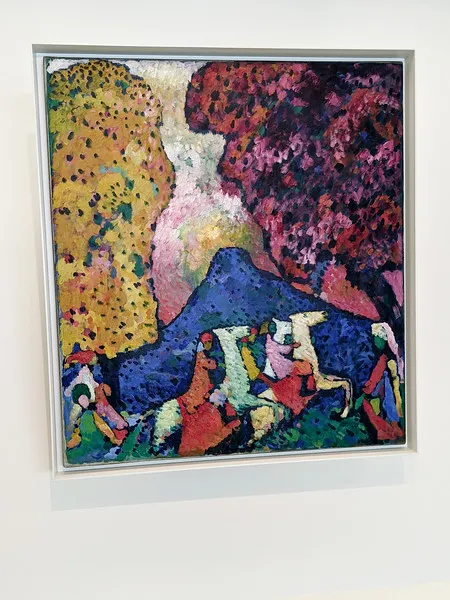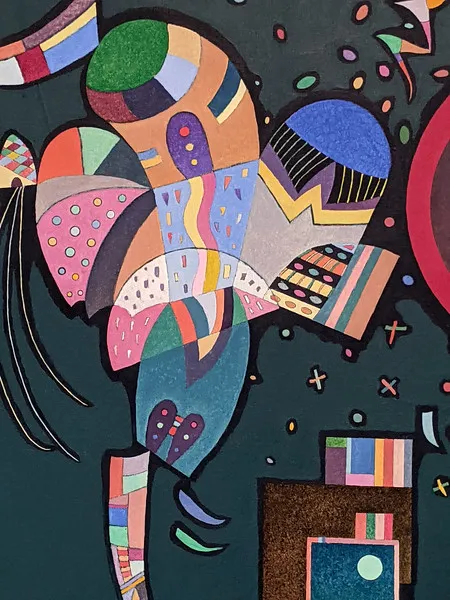Today I am starting the 2022 Art Talk theme on Artists.
Art Talk is going into is 5 years... Amazing!
2018 A collection of all different themes in art
2019 Travel
2020 Tours of the National Gallery of Art in DC
2021 Architecture
2022 Artists
Through the past four years I have highlighted 11 different artists and recently @rosiew asked me why Sargent and Whistler were some of my favorite 19th century artists. I did a post on each of them and then I thought of other artists I would like to highlight as well.
Here is a collection of posts about artists: Artists Highlighted
We are going to start the 2022 theme of Artists with Vasily (or Wassily) Kandinsky.

Vasily Kandinsky
Composition 8, 1923
Guggenheim Museum, New York City
My Introduction to Kandinsky
I was introduced to Wassily Kandinsky in October 2021 when I visited the Guggenheim Museum in New York City for the first time. I am not a big fan of modern art and so I knew very little, if anything, about Kandinsky before going to the Guggenheim.
Solomon Guggenheim was a great art collector in the late 1800s and early 1900s in America. He traveled to Germany in the 1930s and met Kandinsky at the Bauhaus where he was teaching at the time. Solomon bought Composition 8 (above). He then continued to purchase from Kandinsky for the next 20 years amassing a collection of over 150 works by Kandinsky.
The exhibition at the Guggenheim is called Vasily Kandinsky: Around the Circle and runs October 8, 2021- September 5, 2022.
I enjoyed seeing Kandinsky. I was quite amazed at his technical skill and use of lines, shapes, and colors.
Guggenheim Museum
Here are a couple of picture of the Guggenheim and you can see how fitting the theme around the circle is for the exhibition.


I also did a post about The Guggenheim.
Let me take you on a walk around the circle of the Guggenheim and introduce you to Kandinsky.

This will be a short introduction to Kandinsky and his art. In addition to the sources below I also got a lot of information from the plaques in the Guggenheim next to the art.
Kandinsky
Kandinsky is credited with being one of the pioneers in abstract art. He was born in Russia in 1886 into a wealthy family. He went to school in Russia and became a economic and law professor. He gave up this promising and lucrative career at the age of 30 and moved to Munich, Germany and enrolled in art school. He returned to Russia in 1914 at the start of World War I. He returned to Germany in 1920 and taught at Bauhaus until 1933 when the Nazi closed it. He then moved to France where he lived out the rest of his life, dying in 1944 at the age of 58.
Early 1900s
Kandinsky, like Impressionist artists, was painting en plein air (or outside). Here are we have a few of his early work in Munich in the early 1900s.

Vasily Kandinsky
Amsterdam-View from the Window, 1904
Guggenheim Museum, New York City

Vasily Kandinsky
Fishing Boats, Sestri, 1905
Guggenheim Museum, New York City

Vasily Kandinsky
Landscape with Rolling Hills, 1910
Guggenheim Museum, New York City

Vasily Kandinsky
Blue Mountain, 1908-1909
Guggenheim Museum, New York City
Throughout all these early painting we can see Kandinsky's strong use of color. Here we see one of his common themes, which is a man riding a horse. He even co-founded the Blue Rider group with other like-minded artists such as August Macke, Franz Marc, Albert Bloch, and Gabriele Münter.
Kandinsky taught at an art school in Munich that he cofounded and in 1902 he asked one of his students (Gabrielle Munter) to travel with him. He traveled extensively with Gabriele. She was his companion until 1914.
Move to Abstraction
This is where his art really started to be more abstract.

Vasily Kandinsky
Small Pleasures, 1913
Guggenheim Museum, New York City

Vasily Kandinsky
Painting with white border, 1913
Guggenheim Museum, New York City

Use of shapes
Now we are moving into a time where Kandinsky really used a lot of shapes and colors and even named the paintings after those shapes and colors.
 |  |  |
|---|---|---|
| Red Oval | Blue Circle | Three Sounds |
This is a very impressive painting! It is part of Kandinsky's Composition series that he did between 1910 and 1939 that investigated colors and forms and their psychological and spiritual effects. He also authored a book about the spiritual aspects of art called Über das Geistige in der Kunst.
It is also during the 1920s that Kandinsky returns to Germany and is teaching at Bauhaus and Solomon Guggenheim meets him and purchase his paintings. He also has his first solo show in 1923.

Vasily Kandinsky
Composition 8, 1923
Guggenheim Museum, New York City
Biomorphic
Biomorphic refers to abstract forms or images that evoke naturally occurring forms such as plants, organisms and body parts.
During the 1930s and 1940s he was painting biomorphic paintings. These were some of my favorites!

Vasily Kandinsky
Various Acions, 1941
Guggenheim Museum, New York City

Vasily Kandinsky
Dominate Curve, 1936
Guggenheim Museum, New York City

Vasily Kandinsky
Around the Circle, 1940
Guggenheim Museum, New York City
 |  |  |
|---|
It would also be interested to dive into how music was connected to Kandisky and his work.
Hope you have enjoyed this look at Kandinsky, through this paintings in the Guggenheim, as much as I enjoyed researching and putting this post together.
Sources:
Guggenheim-Vasily Kandinsky
Guggenheim- Vasily Kandinsky: Around the Circle
YouTube- 10 Amazing Facts about Wassily Kandinsky
YouTube- Wassily Kandinsky: 6 Minute Art History Video
Wikepedia- Wassily Kandinsky
Guggenheim- Solomon R Guggenheim
MoMA- Biomorphic

Art Talk Series Highlights
Artists Highlighted Collection
Art Talk: 2021 Posts
Art Talk: 2020 Posts
Art Talk: 2019 Posts
Art Talk: 2018 Posts